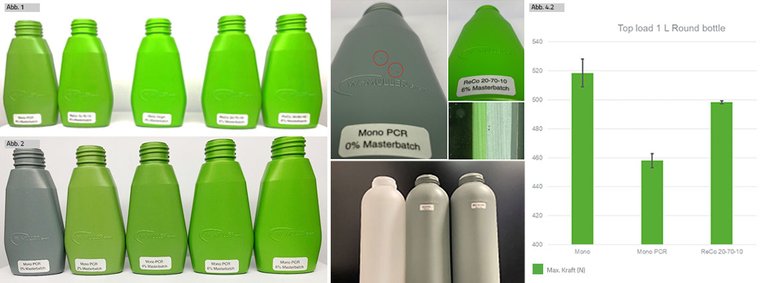Improving optics with PCR - is that possible?
Plastics and sustainability | 20. September 2022

Research was carried out again in the W. MÜLLER GmbH technical center. Our Technical Center Manager Varinia Lück recently presented new findings for the need of masterbatch in PCR bottles. In the industry, in retail and even among end users, the rumor persists that recycled bottles cannot be as beautiful as new ones. But we can finally put this rumor to rest:
In their latest series of experiments, Varinia Lück and her team tested how much masterbatch is needed to ensure perfect coverage of a gray PCR material and whether it really takes that much more color to achieve the same optical results. Of course, the amounts depend on the wall thickness and the materials used in each case. In our experiments, single-layer bottles of PCR were first dyed with green masterbatch (4% masterbatch - 0.45 g masterbatch for the 11 g bottle). The bottle was clearly different from the virgin bottle. Even with 6% and 8% masterbatch, the desired color could not be achieved. (Pic. 2)
In the following test, the bottle was produced in 3 layers, with masterbatch in the outer layer and the same gray PCR in the middle layer. Here, complete gray coverage and color uniformity to the virgin bottle could already be achieved with 18g masterbatch (8% masterbatch in the outer layer). (Pic. 2)
The trials clearly show that processing PCR materials in a three-layer process significantly improves the appearance of the bottles, with simultaneous material and cost savings.
Another advantage also results from production in a two- or three-layer process: The coverage of specks and impurities, which are unavoidable in PCR materials. And it is also not necessary to work them out of the raw material completely if they can be covered. This in turn saves steps and energy in the preparation of the recyclates.
A frequent question that also illustrates the concerns of our clientele is the issue of the mechanical properties of a bottle that consists largely of PCR materials. Will the bottle made of recycled material withstand the external influences, pressures and loads in distribution?
In our tests, it emerged clearly that a proportion of 70% PCR is optimal. With up to 70% PCR content, optimal ReCo3 bottles were still produced in our trials, which our technical center team also documented in elaborate tests. A bottle consisting of 100% PCR generally no longer has by far the same mechanical properties as a virgin bottle when produced in a single layer. This is shown by the results of our top load tests. A bottle produced in a three-layer process with 70% PCR content, on the other hand, comes much closer to the top load results of the virgin bottle. (Pic. 4.2)
Research into the recyclability of our raw materials has been a high priority at W. MÜLLER for many years.
We always work with the awareness that we have to safe resources and offer our clientele the possibility of processing materials that are in line with the spirit of the times on their W. MÜLLER equipment without any worries or hurdles. Because an investment at W. MÜLLER has always been an investment in the future. And it should remain so.
In addition to a long and low-maintenance service life, we also demand that our products be able to process recyclates and alternative materials without any problems. We are also expanding our range of products to make this processing even easier for you, for example with our screen changers. Feel free to contact us at any time!
We invest a lot in our research and look forward to any exchange with you. We would be pleased to welcome you to an exchange of experiences in our Technology Center or to support you with a training course in our W. MÜLLER Academy to set up your production in a future-proof way. Benefit from our many researches and blow molding knowledge.
Discuss this and many other topics with us at the K-show. We cordially welcome you at our booth A38 in hall 14!